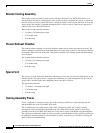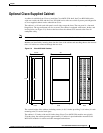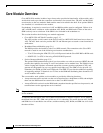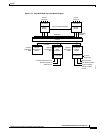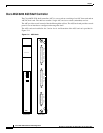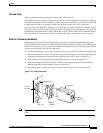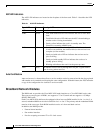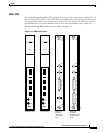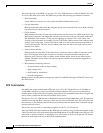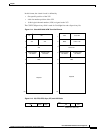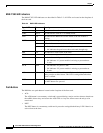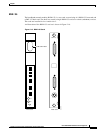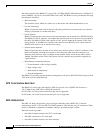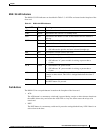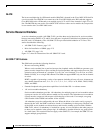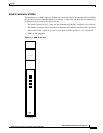
2-16
Cisco MGX 8220 Installation and Configuration
Release 5.0, Part Number 78-6430-03 Rev. D0, November 2003
Chapter
Core Module Overview
The major function of the BNM is to provide a T3 or E3 ATM interface to a BNI or BXM-T3/E3 card
in a Cisco BPX 8600 series node. The BNM also provides the following miscellaneous functions:
• Shelf mastership
Selects which core card to use as the master and which redundant bus to use.
• Cell bus mastership
BNM polls the other cards on the bus and grants permission to transmit cells across the bus. Polling
is performed on a round-robin basis.
• Clock selection
BNM manages the clock selection and synchronization for the entire Cisco MGX 8220 shelf. The
BNM selects, regulates, and outputs the selected clock for use by each service module in the shelf.
The BNM back card contains a T1/E1 port for inputting an external T1/E1 clock source. Two
versions of the line module are available. Version T3E3-B has a BNC external clock connector used
with E1 clock timing input. Version T3E3-D has a DB-15 external clock connector used with T1 or
E1 clock timing input. The shelf can also obtain clock from the DS3 or E3 trunk itself or use an
internal clock source.
• External alarm interface
BNM provides the activation of four alarm relays, which are wired to a DB-15 connector on the
back card faceplate allowing the customer to wire their own cable from the connector to an
indicator panel. The four relays are Major Alarm Audible, Major Alarm Visual, Minor Alarm
Audible, and Minor Alarm Visual. The pinouts for this connector are provided in Appendix B,
“Specifications.”
• Miscellaneous monitoring functions
–
Fan performance in the cooling assembly
–
Input voltage levels
–
Shelf intake air temperature
–
In-band management
BNM provides a separate path for management of the Cisco MGX 8220 using an ATM VCC from across
the ATM network.
ATM Trunk Interface
The BNM card accepts and transmits ATM cells over a T3 or E3 line interfaces at 44.736 Mbps or
34.368 Mbps respectively, using Cisco StrataCom Trunk Interface (STI) protocol asynchronously.
Framing occurs on the card using C-bit parity. An 8-kHz clock is extracted from the received signal and
can be used to synchronize the entire Cisco MGX 8220 system.
The physical T3 or E3 ATM interface to the BNM is achieved using the BNM back card. This physical
connection is made with BNC connectors. There are also relays on the back card. These relays provide
the continuity or discontinuity between the internal circuitry and the external BNC connectors for the
transmit and receive lines.
These relays are also used as a mechanical loopback for the T3 or E3 bit stream.
The Cisco MGX 8220 shelf implements the ATM STI cell format by using slot/channel numbers in the
VPI/VCI fields in the cell format used between the BNM and the Cisco BPX 8600 series BNI port. The
cell format is shown in Figure 2-14 and Figure 2-15. The format on the left is the general STI format,
the format on the right is the Cisco MGX 8220 implementation.



